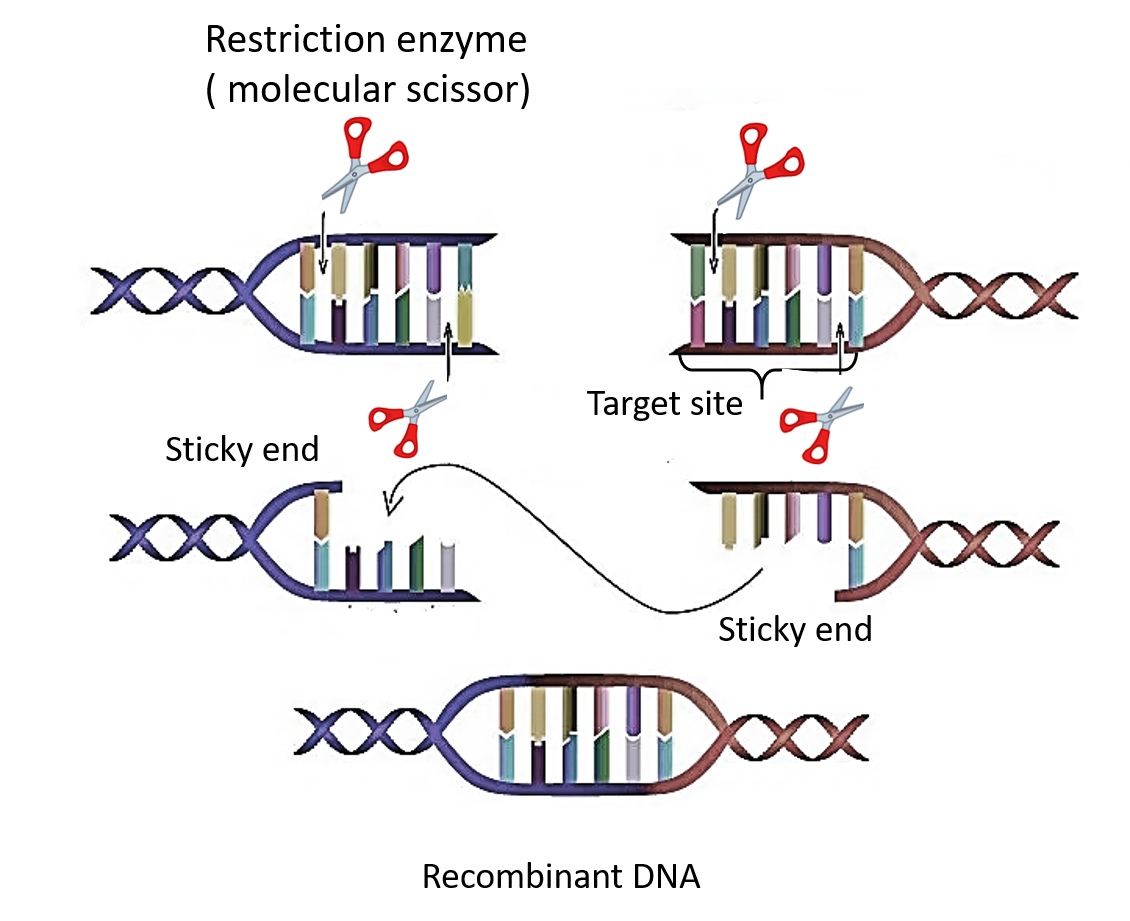
What does R indicate in EcoRI?
(a) Enzyme isolated from a strain of bacteria
(b) Genus of bacteria
(c) Sequence of enzyme
(d) Species of bacteria
Answer
567.6k+ views
Hint: Hamilton Othanel Smith was awarded the Nobel Prize in Physiology or Medicine in 1978 for its discovery.
Correct step by step answer:
R is referred to as a restricted enzyme also called restriction endonuclease (a protein produced by bacteria that divides DNA) .
Restriction enzymes divide foreign DNA in the bacterial cell, at specific sites along the molecule. Later R enzymes are isolated from bacterial cells and used in the laboratory to manipulate those fragments of DNA that contain genes.
So, the correct answer is "enzymes isolated from a strain of bacteria".
Additional information:
- Bacteriophages are bacteria that use an R enzyme to defend against bacterial viruses.
- When a bacterium is infected by phage, it transfers its DNA into the bacterial cell so that it might be replicated.
- Replication of the phage DNA is prevented by cutting it into many pieces through restriction enzymes.

- For their ability to restrict, or limit, the number of strains of bacteriophage that can infect a bacterium, the enzymes are named restriction enzymes.
- A short, specific sequence of nucleotide bases was recognized by each restriction enzyme. These regions are called recognition sequences, or recognition sites, which are randomly distributed throughout the DNA.
- Different bacterial species make restriction enzymes to recognize different nucleotide sequences.
Note:
- Hamilton O. Smith: Discovery and use of ‘type II’ restriction enzymes.
- Werner Arber: Was awarded Nobel prize jointly with Hamilton O. Smith for the discovery of Restriction enzyme.
- Four types of restriction enzyme are-
Type I restriction enzyme
Type II restriction enzyme
Type IV restriction enzyme
Type III restriction enzyme
Correct step by step answer:
R is referred to as a restricted enzyme also called restriction endonuclease (a protein produced by bacteria that divides DNA) .
Restriction enzymes divide foreign DNA in the bacterial cell, at specific sites along the molecule. Later R enzymes are isolated from bacterial cells and used in the laboratory to manipulate those fragments of DNA that contain genes.
So, the correct answer is "enzymes isolated from a strain of bacteria".
Additional information:
- Bacteriophages are bacteria that use an R enzyme to defend against bacterial viruses.
- When a bacterium is infected by phage, it transfers its DNA into the bacterial cell so that it might be replicated.
- Replication of the phage DNA is prevented by cutting it into many pieces through restriction enzymes.

- For their ability to restrict, or limit, the number of strains of bacteriophage that can infect a bacterium, the enzymes are named restriction enzymes.
- A short, specific sequence of nucleotide bases was recognized by each restriction enzyme. These regions are called recognition sequences, or recognition sites, which are randomly distributed throughout the DNA.
- Different bacterial species make restriction enzymes to recognize different nucleotide sequences.
Note:
- Hamilton O. Smith: Discovery and use of ‘type II’ restriction enzymes.
- Werner Arber: Was awarded Nobel prize jointly with Hamilton O. Smith for the discovery of Restriction enzyme.
- Four types of restriction enzyme are-
Type I restriction enzyme
Type II restriction enzyme
Type IV restriction enzyme
Type III restriction enzyme
Recently Updated Pages
Master Class 12 Business Studies: Engaging Questions & Answers for Success

Master Class 12 Economics: Engaging Questions & Answers for Success

Master Class 12 English: Engaging Questions & Answers for Success

Master Class 12 Maths: Engaging Questions & Answers for Success

Master Class 12 Social Science: Engaging Questions & Answers for Success

Master Class 12 Chemistry: Engaging Questions & Answers for Success

Trending doubts
What are the major means of transport Explain each class 12 social science CBSE

Which are the Top 10 Largest Countries of the World?

Draw a labelled sketch of the human eye class 12 physics CBSE

How much time does it take to bleed after eating p class 12 biology CBSE

Explain sex determination in humans with line diag class 12 biology CBSE

Differentiate between homogeneous and heterogeneous class 12 chemistry CBSE




